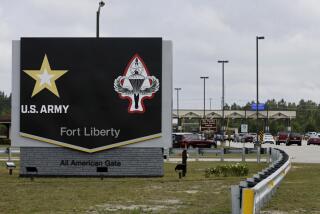Pentagon May Be Losing Operation Code Name Battle : Military: Titles these days lack the inspiring quality of ‘Operation Anvil,’ ‘Operation Torch’ and other World War II-era monikers.
WASHINGTON — They beckon from the past, the great military battles and their still-stirring code names: Operation Overlord, the D-Day invasion of Europe. Operation Torch, the U.S. landing in North Africa. Operation Anvil, the Allied liberation of southern France.
Now fast-forward to the 1990s:
* The U.S. intervention in Somalia was called Operation Restore Hope.
* The U.S. rescue effort in Rwanda was named Operation Support Hope.
* The American intervention in Haiti is known as Operation Uphold Democracy.
* And last month’s urgent U.S. mobilization to prevent Iraqi troops from invading Kuwait again was Operation Vigilant Warrior.
“Not the sort of thing they’ll remember in the year 2021,” a Pentagon strategist conceded.
The disparity points to a paradox: While the quality of U.S. forces and their weapons have risen to an all-time high, the art of finding inspiring code names for what they do has become an unexpected casualty of East-West peace.
Even former Joint Chiefs of Staff Chairman Colin L. Powell, himself no stranger to the plain-vanilla turn of phrase, found Operation Productive Effort--the name proposed for a U.S. humanitarian aid mission to Bangladesh in 1991--too humdrum to let out of the Pentagon.
Defense Department planners eventually changed it to Operation Sea Angel, but that was inspired by the Bangladeshis, who first used the term to describe the Marine helicopter pilots who delivered relief supplies.
It was not always this boring. Winston Churchill, the great communicator of World War II, placed special importance on the need for bold-sounding code names for military operations.
He favored monikers such as “Overlord”--which he approved personally--in hopes that they might inspire Allied troops (and presumably entice historians as well). In 1943, he even laid down guidelines that still serve as a standard for would-be battle-dubbers.
The Defense Department maintains a military-wide computer database--known, in typical Pentagon style, by the initials NICKA, for Codeword Nickname and Exercise Term System--that seeks to prevent duplication by allocating specific initials to individual commands.
Navy Lt. Cmdr. Edwin A. Shuman, who heads the NICKA unit, said combat commanders are assigned a series of double-letter blocks--from EB through EW, for example--with the first word (say, “Early,”) already provided.
The commanders then fill in the second (Early Bird through Early Wake-Up, to continue the example). In a high-profile operation, the names are reviewed by the Joint Chiefs of Staff. Once taken, a name is not used again for another two years.
All this is just to develop two-word nicknames, which are designed to inspire the troops or to send some sort of message to the public. The actual code names used by the military are only a single word long and are classified as top secret.
Shuman said the services use up to several hundred code names each year, both for combat operations and for training exercises. Some--such as Team Spirit, the annual joint U.S.-South Korean maneuvers--are given the same name year after year for greater visibility.
There is a certain amount of risk in striking out too boldly in picking out a code name.
An Army Reserve unit that once tried to name a road-building venture in Honduras “Operation Blazing Trails” ran into trouble when a too-literal translation came out close to the Spanish-language name for Shining Path, the notorious Maoist guerrilla group in Peru.
It was abruptly withdrawn.
Still, as the evidence clearly demonstrates, too many of today’s code names are (a) lackluster, (b) uninspiring, (c) not very stirring and (d) just plain dull.
One exception--Operation Desert Storm, the name given to the 1991 Persian Gulf War--isn’t bad by historical standards. But the buildup that preceded it was labeled Operation Desert Shield, a name that, perhaps justifiably, already has been all but forgotten.
The name “Vigilant Warrior,” for the most recent U.S. deployment to Kuwait, has not found a permanent slot in many memories either and that operation took place barely a month ago.
Stephen H. Hess, a Brookings Institution scholar, pointed out that the trend toward more lackluster code names runs counter to today’s emphasis in government on public relations.
“The Pentagon is becoming more and more sophisticated at public relations, with more in-house flacks, but somehow these names sound as though they were written by committee--and the answer is, they probably were,” Hess said.
“(Gen. Dwight D.) Eisenhower probably woke up on the morning of the operation, and said: ‘I know--we’ll call it Torch.’ Now the code name is probably decided by an interdepartmental study group. What a comedown from before!”
Although no one knows precisely when military forces began using code names routinely, the late New Zealand etymologist Eric Partridge reported that the practice already had become entrenched during Elizabethan days, when London recorded almost 200 military code names.
Partridge’s own research showed that many of the code names of that era were applied to persons or institutions. Lord Burghley, for example, was said to have used signs of the Zodiac, such as “Cancer” and “Leo” for top officials of that day.
Partridge estimated that during World War II the Allies and Axis powers (Germany, Italy and Japan) together devised more than 10,000 such names. The space race has added several hundred more. Even big companies use code names today.
But Soldiers, a U.S. Army publication, suggested that Churchill may have set the standard. Acutely aware of the value of symbolism in maintaining fighting spirit, he rejected names that he thought too boastful, frivolous, depressing or mundane.
“The world is wide,” he wrote, “and intelligent thought will readily supply an unlimited number of well-sounding names which . . . do not enable some widow or mother to say that her son was killed in an operation called ‘Bunnyhug’ or ‘Ballyhoo.’ ”
Not surprisingly, Churchill also insisted on approving all code names personally.
Sometimes code names have been designed to deceive an enemy. In 1943 the Allies dumped a corpse off the shores of Spain, with papers describing a fictitious “Operation Husky” to take place there. It kept German intelligence occupied for weeks.
Code names for joint U.S.-British operations came from the Combined British-United States Interservice Code Word Index, which ranged from “Aaron” (the battle of Bulawatan in New Britain) to “Zouave” (an operation in White Horse, Yukon Territory, Canada).
In between were names such as “Baldhead,” (the assault on Masibang, New Guinea) “Brassiere,” (the battle of Ulamaingi, New Britain), “Fiddlestick” (an operation in Vogelkop, New Guinea) and “Yoicks” (fighting at Visayan Sea in the Philippines).
Today’s list is generated entirely by computer, which may explain how the selection got to be so dull. In recent months, the NICKA program appears to have been stuck on the words provide and restore, as in operations Provide Comfort and Restore Hope.
Some analysts suggested that what may be needed now is a new effort dubbed Operation Provide Better Choices, followed by Operation Restore Pizazz to the Pentagon’s code names.
Pentagon’s Name Game
Code names for recent U.S. military operations:
Year Military operation Name 1983 Invasion of Grenada Urgent Fury 1989 Invasion of Panama Just Cause 1990 Buildup in the Persian Gulf Desert Shield 1990 Evacuation in Liberia Sharp Edge 1991 Persian Gulf War Desert Storm 1991 Protection of Kurds in northern Iraq Provide Comfort 1991 Rescue effort in Bangladesh Sea Angel 1992 Enforcement of “no-fly” zone in southern Iraq Southern Watch 1992 Enforcement of “no-fly” zone over Bosnia Deny Flight 1992 Enforcement of allied sanctions in the Adriatic Sea Sharp Guard 1992 Intervention in Somalia Restore Hope 1993 Troops sent to Macedonia Able Sentry 1993 Rescue of boat people off Haiti Able Manner 1994 Aid effort in Rwanda Support Hope 1994 Intervention in Haiti Uphold Democracy 1994 Intervention in Kuwait Vigilant Warrior
Source: Center for Strategic and International Studies
More to Read
Sign up for Essential California
The most important California stories and recommendations in your inbox every morning.
You may occasionally receive promotional content from the Los Angeles Times.










